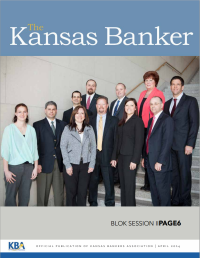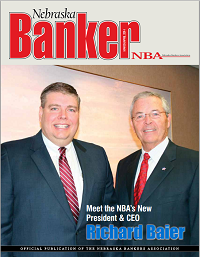It Started with a Tweet #SocialMedia #Banks @ICBA
By: Russ Horn (CISA, CISSP, CRISC)
Publication: ICBA Independent Banker, August 2014
The first tweet ever written was by co-founder Jack Dorsey on March 21, 2006, at 9:50 p.m., which read, “just setting up my twttr.” Now, just over eight years later, Twitter averages more than 500 million tweets per day.* According to a statistic released as part of the ICBA 2014 Top 50 Community Bank Leaders in Social Media, nearly 2,500 banks have a Facebook or Twitter presence, and the numbers continue to exponentially grow. It is apparent everywhere you turn that social media is one of the hottest new communications tools in our society. It is no wonder banks are joining in. In fact, the FFIEC even released guidance in December 2013 on social media, entitled “Social Media: Consumer Compliance Risk Management Guidance.” So how do banks use social media and what do they need to be wary of?

 Not long ago, the Federal Financial Institutions Examination Council (FFIEC) announced and began its examination pilot program about cybersecurity activities, reviewing over 500 community financial institutions as part of its summer examination cycle. The FFIEC says the purpose of this pilot program is to "assess how community financial institutions manage cybersecurity and their preparedness to mitigate increasing cyber risks."
Not long ago, the Federal Financial Institutions Examination Council (FFIEC) announced and began its examination pilot program about cybersecurity activities, reviewing over 500 community financial institutions as part of its summer examination cycle. The FFIEC says the purpose of this pilot program is to "assess how community financial institutions manage cybersecurity and their preparedness to mitigate increasing cyber risks." The previous "year of the security breach" is behind us, and now we find ourselves treading water through a year that so far has been defined by significant vulnerabilities and exposures. How do we proactively protect against these newly discovered threats? Luckily, or unluckily depending on how you want to look at it, due to the nature and severity of some of the recent security breaches we have been given plenty of data to analyze. With each new story, I caught myself repeating some variation of "Why did they allow…? That goes against everything you learn in security 101!" Let's just call this our "opportunity to improve."
The previous "year of the security breach" is behind us, and now we find ourselves treading water through a year that so far has been defined by significant vulnerabilities and exposures. How do we proactively protect against these newly discovered threats? Luckily, or unluckily depending on how you want to look at it, due to the nature and severity of some of the recent security breaches we have been given plenty of data to analyze. With each new story, I caught myself repeating some variation of "Why did they allow…? That goes against everything you learn in security 101!" Let's just call this our "opportunity to improve." Regulatory agencies have been busy this year! This seems to be the year of FILs, OCC Bulletins, and FFIEC documents. Some that came out earlier than that are also seeing an increase in attention. Make sure these areas of information security are addressed in your program (or are at least on your radar) before your next exam:
Regulatory agencies have been busy this year! This seems to be the year of FILs, OCC Bulletins, and FFIEC documents. Some that came out earlier than that are also seeing an increase in attention. Make sure these areas of information security are addressed in your program (or are at least on your radar) before your next exam: Many financial institutions have become very reliant upon service providers for a myriad of banking operations, such as core processing, remote deposit capture, online banking, card processing, or data backups to a cloud provider. Financial institutions depend on these organizations to accurately process transactions and securely store customer nonpublic data in accordance with reasonable internal controls.
Many financial institutions have become very reliant upon service providers for a myriad of banking operations, such as core processing, remote deposit capture, online banking, card processing, or data backups to a cloud provider. Financial institutions depend on these organizations to accurately process transactions and securely store customer nonpublic data in accordance with reasonable internal controls. In December 2013, the FFIEC issued final guidance on Social Media entitled "Social Media: Consumer Compliance Risk Management Guidance." The purpose of the guidance was to help financial institutions better understand the risks of social media and provide some expectations for managing those risks. The FFIEC points out that "the guidance does not impose any new requirements on financial institutions;" however, the guidance does provide considerations financial institutions may use in crafting a risk management program.
In December 2013, the FFIEC issued final guidance on Social Media entitled "Social Media: Consumer Compliance Risk Management Guidance." The purpose of the guidance was to help financial institutions better understand the risks of social media and provide some expectations for managing those risks. The FFIEC points out that "the guidance does not impose any new requirements on financial institutions;" however, the guidance does provide considerations financial institutions may use in crafting a risk management program. I know compliance requirements can feel like a burden…and doing compliance solely for the sake of compliance can really feel like a burden. Taking a step back from the checklists and trying to see the spirit of the law can help to keep you from being overwhelmed. It can also help you clean up the parts of your information security program that may have gotten out of hand over the years. Vendor management is one area that can get overwhelming and unnecessarily complex when you try to check things off without truly understanding the process. Vendor management also seems to be on many examiners' radars this year, so now is a great time to clean up your vendor management program and make it work for you instead of the other way around.
I know compliance requirements can feel like a burden…and doing compliance solely for the sake of compliance can really feel like a burden. Taking a step back from the checklists and trying to see the spirit of the law can help to keep you from being overwhelmed. It can also help you clean up the parts of your information security program that may have gotten out of hand over the years. Vendor management is one area that can get overwhelming and unnecessarily complex when you try to check things off without truly understanding the process. Vendor management also seems to be on many examiners' radars this year, so now is a great time to clean up your vendor management program and make it work for you instead of the other way around. Recently we have seen a focus on vendor management during exams. Regulators have been concerned the quality of third-party risk management practices may not be keeping pace with the increasing level of risk and complexity of these relationships. As a result of this concern and new focus, the OCC released a Bulletin titled "Third-Party Relationships: Risk Management Guidance" on October 30, 2013. The bulletin provides guidance for assessing and managing risks associated with third-party relationships.
Recently we have seen a focus on vendor management during exams. Regulators have been concerned the quality of third-party risk management practices may not be keeping pace with the increasing level of risk and complexity of these relationships. As a result of this concern and new focus, the OCC released a Bulletin titled "Third-Party Relationships: Risk Management Guidance" on October 30, 2013. The bulletin provides guidance for assessing and managing risks associated with third-party relationships. Your Business Continuity Plan (BCP) is your life raft for both expected and unexpected disasters. It is your road map to recovery. Illustrations aside, it's very important, and your employees need to be able to read it. I've heard it said that even an unschooled person should be able to pick up a BCP and get the bank restored properly. While it is important to have a well-thought-out BCP, it's not likely you will round up a team of unschooled persons to read and follow your BCP. The first reason being: most unschooled people can't read. It is more likely that restoration will be performed by you and your employees; better yet, employees who have been hand-picked as capable workers. I make note of this anecdote because banks often design business continuity plans with every single step and click explained for every facet of the organization. As important as it is for your BCP to be thorough, it's just as important for it to be user friendly.
Your Business Continuity Plan (BCP) is your life raft for both expected and unexpected disasters. It is your road map to recovery. Illustrations aside, it's very important, and your employees need to be able to read it. I've heard it said that even an unschooled person should be able to pick up a BCP and get the bank restored properly. While it is important to have a well-thought-out BCP, it's not likely you will round up a team of unschooled persons to read and follow your BCP. The first reason being: most unschooled people can't read. It is more likely that restoration will be performed by you and your employees; better yet, employees who have been hand-picked as capable workers. I make note of this anecdote because banks often design business continuity plans with every single step and click explained for every facet of the organization. As important as it is for your BCP to be thorough, it's just as important for it to be user friendly.